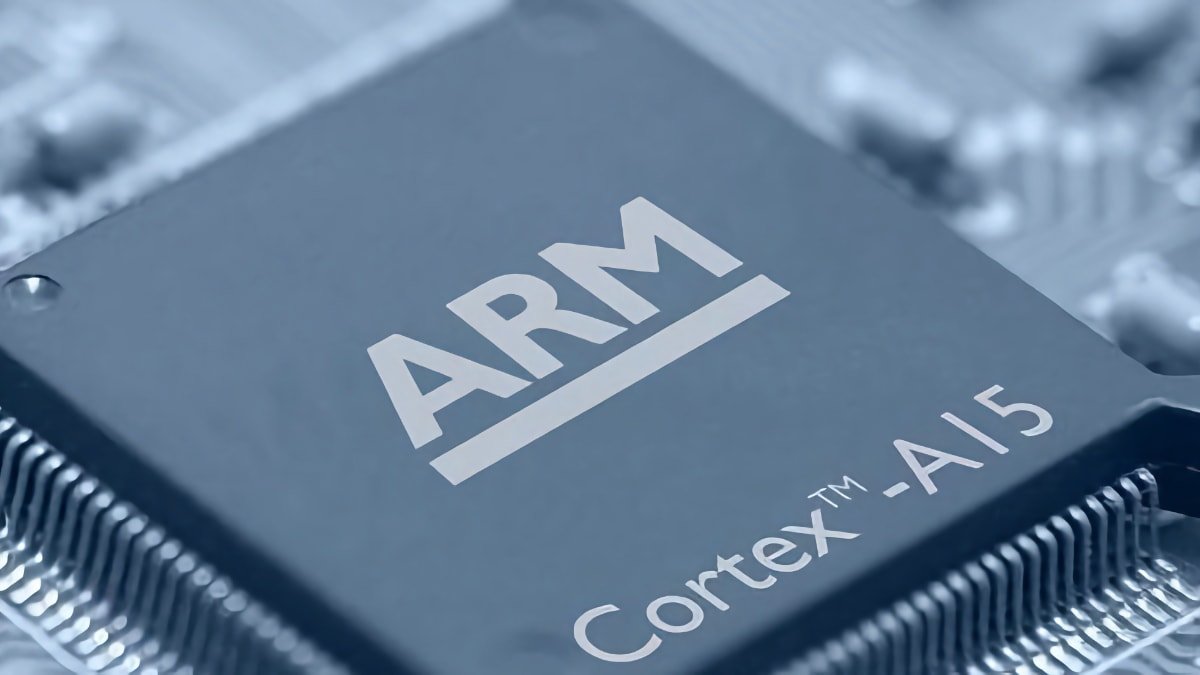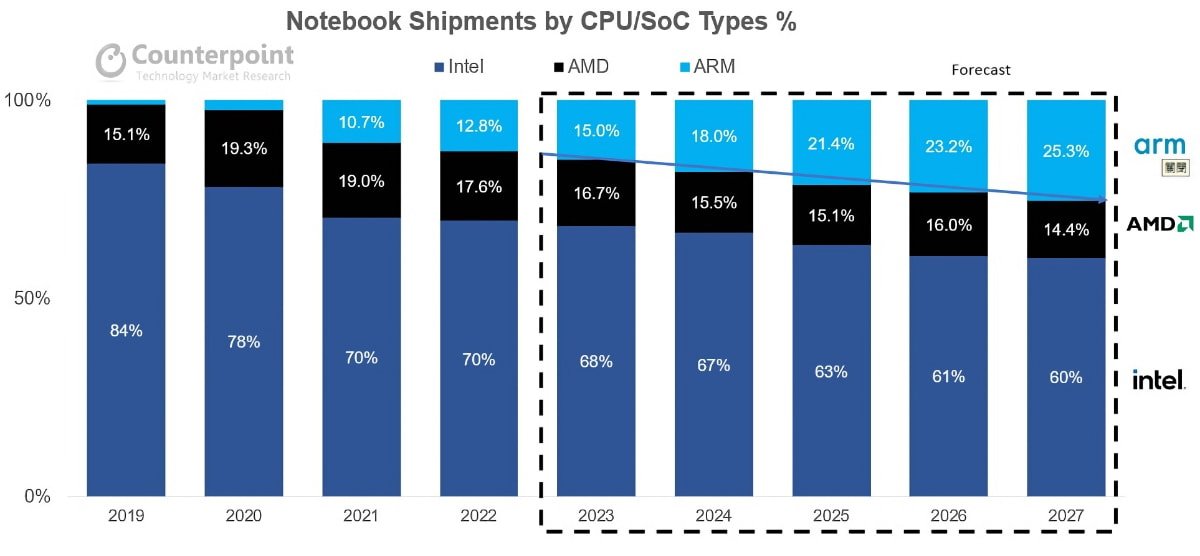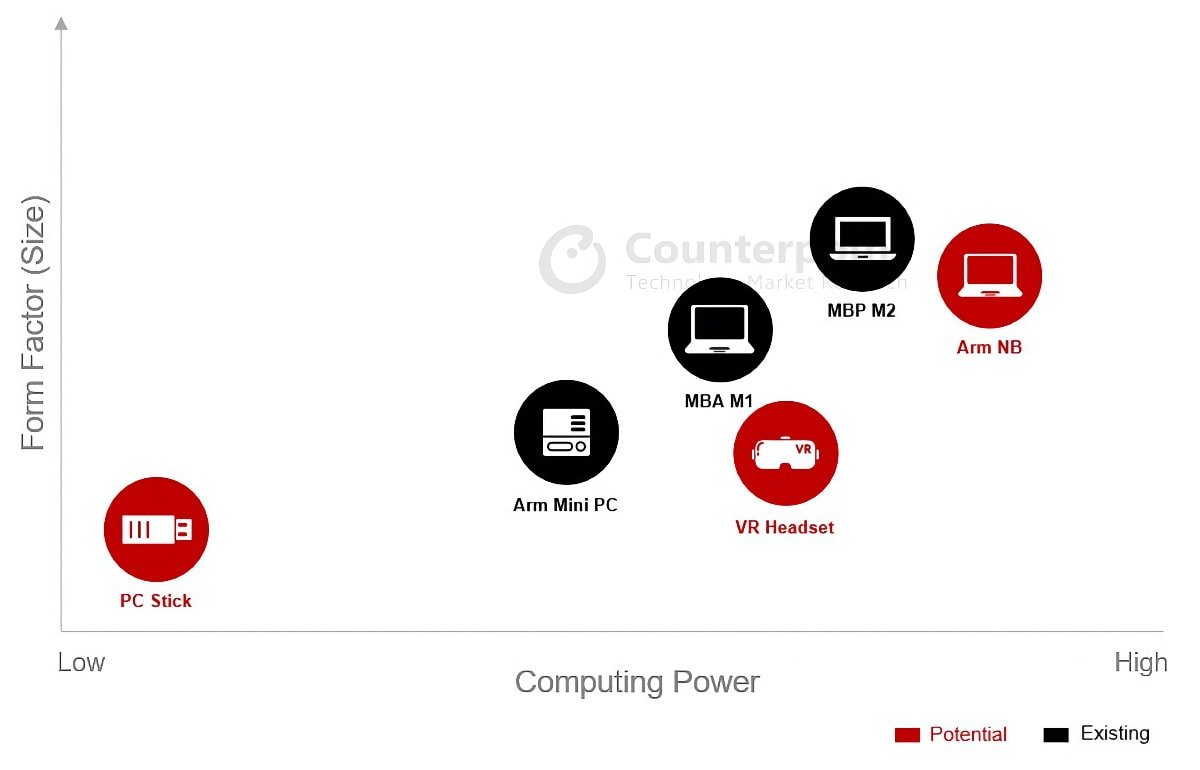Apple Silicon dominates the market for ARM chips & will drive growth
Apple has 90% of the market share for ARM computers thanks to Apple Silicon, and analysts expect the ARM computer market to double.

ARM chip
The newest report from Counterpoint Research expects ARM-based PCs to double in market share by 2027. They hold a 14% market share, and analysts believe it will increase to 25%.
Apple's M-series of chips are primarily based on chip architecture from ARM, which has helped the company gain 90% of the ARM-based notebook computer market. But if companies using ARM chips want to help grow the market, they must address factors like Windows and Office365 support and ensure that native apps are speedy.

Notebook Shipment Share by CPU/SoC Type
Unlike the x86 chip architecture from Intel, designed to be general-purpose processors, ARM-based system-on-a-chips (SoC) are highly customizable. Companies can design these processors as Apple has to include more high-performance CPU cores and integrated memory to compete with x86 CPUs.
The custom cores allow advanced features such as artificial intelligence and machine learning tasks, such as Apple's Neural Engine it includes in its processors. ARM chips can also be more efficient for power and customized to meet specific power requirements.
Integrating GPUs into the chips also improves performance by accelerating computational tasks such as machine learning and image recognition. As a result, it allows for faster and more accurate results in computing and makes it possible to run advanced apps and software on ARM-based computers.

ARM-based PC Potential Applications
Companies can also tailor ARM chips for virtual reality headsets, which are currently based on smartphone processors. ARM chips can help the headsets reach PC-like performance to handle complex applications for virtual reality.
For example, rumors of the VR headset from Apple suggest it could have custom Apple chips included, especially if the company intends the headset to be a standalone device that doesn't rely on an iPhone. One report said it would have processing comparable to the M1 chip, although the M2 chip might also be an option.
Read on AppleInsider

ARM chip
The newest report from Counterpoint Research expects ARM-based PCs to double in market share by 2027. They hold a 14% market share, and analysts believe it will increase to 25%.
Apple's M-series of chips are primarily based on chip architecture from ARM, which has helped the company gain 90% of the ARM-based notebook computer market. But if companies using ARM chips want to help grow the market, they must address factors like Windows and Office365 support and ensure that native apps are speedy.

Notebook Shipment Share by CPU/SoC Type
Unlike the x86 chip architecture from Intel, designed to be general-purpose processors, ARM-based system-on-a-chips (SoC) are highly customizable. Companies can design these processors as Apple has to include more high-performance CPU cores and integrated memory to compete with x86 CPUs.
The custom cores allow advanced features such as artificial intelligence and machine learning tasks, such as Apple's Neural Engine it includes in its processors. ARM chips can also be more efficient for power and customized to meet specific power requirements.
Integrating GPUs into the chips also improves performance by accelerating computational tasks such as machine learning and image recognition. As a result, it allows for faster and more accurate results in computing and makes it possible to run advanced apps and software on ARM-based computers.

ARM-based PC Potential Applications
Companies can also tailor ARM chips for virtual reality headsets, which are currently based on smartphone processors. ARM chips can help the headsets reach PC-like performance to handle complex applications for virtual reality.
For example, rumors of the VR headset from Apple suggest it could have custom Apple chips included, especially if the company intends the headset to be a standalone device that doesn't rely on an iPhone. One report said it would have processing comparable to the M1 chip, although the M2 chip might also be an option.
Read on AppleInsider

Comments
(even has the word 'desktop' in its product description ;-)
Unlike the x86 chip architecture from Intel, designed to be general-purpose processors, ARM-based system-on-a-chips (SoC) are highly customizable. Companies can design these processors as Apple has to include more high-performance CPU cores and integrated memory to compete with x86 CPUs.
Totally ignoring that Apple went to Intel to design the Core Duo for the MacBook Air. Or that Microsoft and Sony get custom-made chips from AMD for their XBox and PlayStation consoles every generation. Or that Valve and Asus went to AMD to get custom-made chips for their consoles.
The custom cores allow advanced features such as artificial intelligence and machine learning tasks, such as Apple's Neural Engine it includes in its processors.
Yeah ... Intel and AMD have their own integrated NPUs also.
ARM chips can also be more efficient for power and customized to meet specific power requirements.
As can x86 chips. The latest AMD 7040 laptop chips give better power per watt than the M1 and M1 Pro. Intel has a whole range of laptop chips that give better power per watt than the iPad Pro does.
Integrating GPUs into the chips also improves performance by accelerating computational tasks such as machine learning and image recognition. As a result, it allows for faster and more accurate results in computing and makes it possible to run advanced apps and software on ARM-based computers.
Literally every single Intel and AMD laptop chip has an integrated GPU and has for decades. Most Intel desktop chips have integrated GPUs too. Only AMD desktop chips regularly lack integrated GPUs. Are they as good as Apple's integrated GPUs? Not yet, though the integrated GPU on the latest AMD laptop chips perform as well as an Nvidia GTX 1650: https://wccftech.com/amd-radeon-780m-rdna-3-igpu-comes-within-striking-distance-of-nvidia-gtx-1650-dgpu/ But they don't have to. Because - unlike Apple Silicon - you have the option of using discrete GPUs with Intel and AMD chips.
As for the unified memory thing: face reality. First off, no one needs it. Apple uses unified memory to maximize performance. Intel and AMD can get the performance they need without it. Second, no one wants it. People prefer the ability to cheaply expand RAM on low and midrange systems. And they prefer the ability to add massive amounts of RAM on high end systems and servers. Being able to buy an entry level system for cheap and upgrade the RAM to 64 GB for $100 is huge. And this site states that actual machine learning workstations often require 1 TB of RAM https://www.pugetsystems.com/solutions/scientific-computing-workstations/machine-learning-ai/hardware-recommendations/#ram so you can forget about the oroposed 192 GB RAM Mac Pro being used by that crowd.
Look, I am not saying that the people who write for Apple Insider need a computer engineering background or anything like that, but so much in this article can be easily debunked just by spending 30 minutes on Anandtech. At least the magical and wishful thinking that Daniel Eran Dilger was infamous for on Apple Insider was mostly opinion.
- Chip architecture? No. ARM ISA? Yes. And that only applies to CPU cores.
- NPU is a separate block, not sure if it's wholly an Apple design or not?
- GPU is of Imagination Technologies lineage.
- Secure Enclave is (was) part of original ARM SoC design, not sure if current implementations are based off of it or not.
Anyone who paid attention to Apples acquisitions (AppleInsider articles) over the years knew about PA Semi, Intrinsity, and Anobit and their timing in Apple search/quest to be independent, in software and hardware, and the current results speak for themselves.
Finally, Intel, AMD along with Nvidia are not good when it comes to being used in laptops, when unplugged from a wall, they are desktop computers, masquerading as a laptop, some PC users are starting to get a clue about the difference and they’re not happy about it just looking at some of the comment sections Apple solutions are far ahead of the competition in that area.
https://www.youtube.com/watch?v=JM27aT9qhZc
https://www.youtube.com/watch?v=u4Pxh2khHbg